Tehran Lawmaker Rebukes Russia For Using Iran As ‘Playing Card’
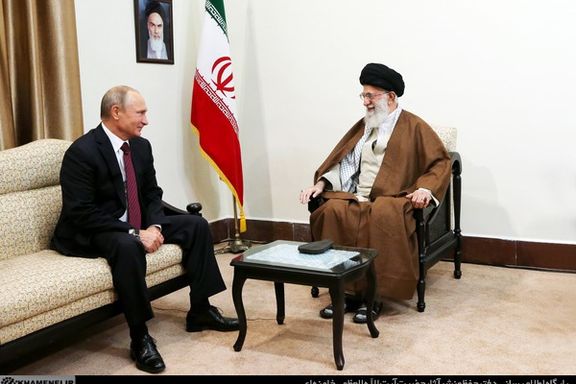
A member of the Iranian parliament's national security commission has asserted that Russia cannot treat Iran as a mere "trump card or playing card."

A member of the Iranian parliament's national security commission has asserted that Russia cannot treat Iran as a mere "trump card or playing card."
Ebrahim Azizi underscored that the resilience of Russia's "glass palace" is directly linked to Iran's power and influence in the region.
Tehran and Moscow have been close political and military allies in the Middle East and the wider region for the past decade.
The declaration comes in response to Moscow's public endorsement of Arab claims to three strategically important Iranian islands in the Persian Gulf.
In a joint declaration issued in Morocco, Russia and the Persian Gulf Cooperation Council (GCC) openly expressed their support for the United Arab Emirates, which lays claim to sovereignty over the islands. The ongoing discord surfaces every time during joint summits between the GCC and the Russian Federation, operating within the framework of Russian-Arab Cooperation.
Criticism has emerged from various quarters in Iran, including the media, opposition activists, and the general public, who perceive the regime's response to Russia's alignment with Arab states as inadequate.
Despite historical and geographical evidence validating the islands' connection to Iran, the United Arab Emirates consistently asserts its claim, characterizing the situation as the "continued occupation by the Islamic Republic of Iran."
Originally under British control in 1921, the islands took on new significance when, on November 30, 1971, just two days before the UAE officially federated, the Iranian navy secured control. Presently, Iranian forces maintain control of the islands, with only Abu Musa hosting a population of fewer than two thousand civilians.
Russia's alignment with Arab states has ignited discussions within Iran about the potential exploitation of Moscow's ties with Tehran in recent years, raising concerns about the geopolitical implications of the alignment.

With Iran's inflation rate soaring, a new report suggests that the price hikes in most provinces are higher than the average figure announced by the authorities.
Fararu website in Tehran reported on Friday that the point-to-point inflation rate in December once again surpassed the 40% mark after five months. The index indicates that Iranian households spent approximately 40% more in the past month compared to the corresponding period of the previous year to meet their needs or purchase a range of goods and services.
According to the Iran Statistical Center's definition, point-to-point inflation rate represents the percentage change in the average of the price indices in comparison to the year before, providing a more tangible perspective on understanding price hikes. The reported point-to-point rate for the past month was 44.4% while the government had predicted an annual rate of 25 percent for the current Iranian year (started March 21).
There are no independent figures on the economy and no non-governmental entities to verify figures published by the authorities. Some politicians and media say that the real rate of inflation is higher that what the government announces.
The highest inflation rate this month was reported in hotel and restaurant services at 56.5 percent, exceeding about 16 percent over the average annual rate of about 40 percent promulgated by the authorities. Inflation for clothing and shoes was at 47.2%, cigarettes at 45.8%, recreation and culture at 44.1%, education at 42% and foods at 41.3%.
Notably, the prices of red and white meat have surged by about 95% in the last 12 months, also surpassing the overall inflation rate. Lawmaker Asghar Salimi cautioned earlier this month that meat is now excluded from the typical Iranian household's food basket, emphasizing the potential consequences for the next generation.
Iranian authorities use different rates for different political agendas. For example, when they aim to defend low salary increases for government sector workers, they use lower inflation figures, but when they want to justify the 34% rise in tariffs – announced Friday – they say the increase is less than the 40% general inflation.
Additionally, the government also focuses on the average for the entire country to decrease the figures, making the best uses of the poor provinces where goods and services are cheaper. According to the latest data, the point-to-point inflation rate for the Yazd province was more than 50% this month, the highest among the 31 provinces, suggesting that Yazd residents are more affected by inflation than those in any other province.
The Islamic Republic has been struggling with high inflation since 2019, but the raging inflation since May 2022 has been worse from previous years. Last May, the government eliminated an annual food import subsidy of $10-14 billion, which immediately led to steep price increases. This was followed by a fall in the value of the national currency, making imports more expensive for the population. Iran’s ruler Ali Khamenei has dubbed the current year as “the year of controlling inflation”, a promise also repeated by President Ebrahim Raisi, but reminiscent of similar slogans in previous years.
Economist Ali Sa’dvandi wrote on social media that “The year of controlling inflation concluded with a relative failure in achieving the goal.”
Addressing the Raisi administration in a sarcastic tone, he said, “You controlled the foreign currency market, decreased housing prices, slowed down the rise in the money supply and balanced out the banks’ shortfall in capital... so how did you fail to control inflation?”
When the central bank resorts to printing money without sufficient economic growth or foreign currency revenues, the money supply increases fast, which in turn leads to more currency devaluation and inflation. The biggest immediate reason for printing money is government borrowing from the Central Bank of Iran to bridge its budget deficit estimated to be at 50 percent.

Israel has completed a series of extensive strikes against Hezbollah targets in Lebanon, attacks which have impacted the Iran-backed group's positioning near the border.
Israeli military spokesperson Rear Admiral Daniel Hagari said in a televised statement on Friday, "We continue intensive strikes to hit Hezbollah's deployment close to the northern border."
"It no longer looks as it did on October sixth, nor will it," he said about the situation on Israel's northern border with Lebanon, where Hezbollah is entrenched.
Hagari said the targets of the recent synchronized air, tank and artillery strikes included launch pads, military compounds and militant squads.
Hezbollah has been trading fire with Israel at the border since its Palestinian ally Hamas attacked Israel on October 7, igniting a conflict that has drawn in the heavily armed group and other Iran-aligned factions across the Middle East.
Iran supports Hamas but says it did not play any role in the Islamist militants' terror attack that triggered the current crisis. Tehran also denies involvement in the recent attacks on vessels in the Red Sea by Houthis, another group backed by Iran.
But the violence has largely been contained to areas at the border, shaped by what observers have called unwritten rules of engagement between adversaries that have long threatened each other with catastrophic damage in the event of war.
Israel has said it is not seeking to open a front in the north. Israeli Prime Minister Benjamin Netanyahu has warned that Beirut would be turned "into Gaza" if Hezbollah started an all-out war.
(With reporting by Reuters)

As 2023 ends, a human rights group has documented numerous cases of violations, including those targeting religious and ethnic groups, women and labor activists.
Human Rights Activists in Iran (HRA) published its annual report for 2023 on December 28, in which diverse cases of human rights violations were detailed and categorized.
Spanning January 1 to December 20, 2023, the publication is the result of the collection, analysis and documentation of 9,656 human rights reports from 111 media and legal sources.
Crackdown On Labor Activists
According to the report, at least 2,021 protest rallies were held in Iran in 2023, the majority of which were trade union and labor demonstrations, including 111 labor strikes. Security and intelligence agencies used intimidation, arrests and prosecutions to intimidate labor activists.
Over the past months, protests and strikes have continued in different sectors as the Islamic Republic grapples with growing unrest fueled by unmet demands from retirees and workers.
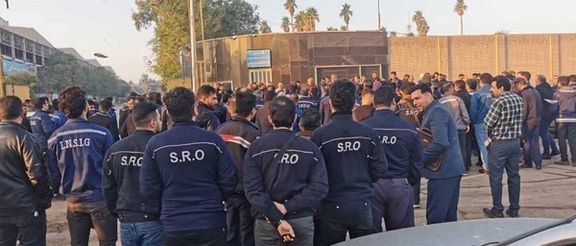
Toward the end of December, workers at the Esfahan Steel Company halted operations, conveying their discontent through organized gatherings and chanting slogans.
Amidst the labor unrest, the regime-run Statistics Center of Iran (SCI) reported a household inflation rate of 45.5%. Alarmingly, one-third of the country is experiencing inflation rates exceeding 50%, as indicated by the same report.
Ongoing Repression Of Ethnic, Religious Minorities
The HRA 2023 report also stated that 324 people were arrested over their ethnic activism, 19 of whom were given 984 months of imprisonment by the Islamic Republic’s judiciary. In comparison with 2022, the numbers show a 44-percent increase in arrests and a 31-percent increase in prison sentences given to ethnic activists in Iran.
142 people were arrested for religious reasons and a total of 5,113 months of imprisonment were handed down to members of religious monitories in Iran. The HRA went on to say, that 85 percent of the reports regarding rights violations of religious monitories concern the Baha’i community.
In November, the Court of Appeals in northern Mazandaran province sentenced 14 Baha’i citizens to imprisonment and fines.
The Baha’i faith is not recognized as a legitimate religion by Iran’s Shiite clerical regime, leading to systematic and longstanding violations of the rights of Baha’is in the country.
Approximately 300,000 Baha'is reside in Iran, and they frequently document a pattern of regular rights violations. The violations encompass harassment, forced displacement from their residences and businesses, and unequal treatment regarding government employment and access to higher education.
Regime Targets Women Activists
Women activists were also severely targeted by the Iranian government in 2023. HRW reported that 44 women were arrested for their activism for women’s rights and 3,176 were prosecuted by the government over their refusal to wear compulsory hijab.
26 cases of rape and sexual harassment and 82 cases of murdering women were also documented by HRW. The report also stipulated that the Iranian government systematically deprives LGBT and queer groups of their rights.
In September, the Iranian parliament greenlit a bill titled “Protection of Family Through Promotion of Hijab and Chastity Culture.” Initially introduced by the government and subsequently amended by hardliner lawmakers, the legislation outlined penalties, including substantial fines, for women diverging from the prescribed Islamic dress code.
Freedom Of Speech Violations & Academic Repression
Violating freedom of thought and speech, the Iranian regime arrested 3,130 people in 2023 and handed down 25,124 months of imprisonment, according to the HRA report.
Human Rights Activists in Iran also documented 3,067 cases of university students being summoned to “disciplinary committees” at their academic institutions and 23 cases of interrogations by judiciary and intelligence entities outside universities. School students were targeted by a campaign of mysterious chemical poisoning in late 2022 and early 2023. Six thousand such cases of poisonings were reported in 2023.
Many Iranians suspect the mysterious poisoning incidents that affected tens of thousands of students across the country following anti-government protests were orchestrated as revenge by the regime or the religious hardliners it protects. This was perceived as a measure to intimidate and subdue the youth involved in the protest movement. The poisonings began in Qom on November 30, 2022, spreading nationwide until April, leading to hospitalizations and at least one reported death.
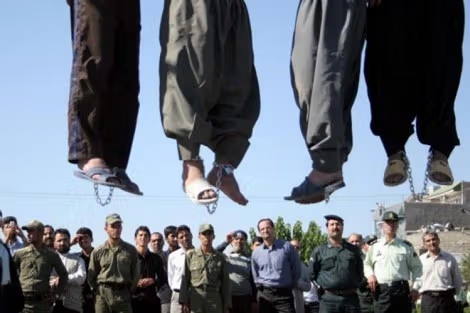
The Islamic Republic’s Juggernaut of Executions
HRA also noted that 746 people were executed in Iran in 2023, with 6 being executed in public, with 56 percent of the executions carried out over drug-related crimes and 35 percent over murder.
The United Nations, the European Union, and human right activists and groups have repeatedly voiced concern over the Islamic Republic’s execution juggernaut and its near-record killing spree in 2023.
In October, UN Secretary-General Antonio Guterres highlighted a surge in executions in Iran in a report submitted to the 78th session of the General Assembly.
A comparison with HRW’s 2022 report it becomes apparent that the Islamic Republic has intensified its crackdown against religious, ethnic and gender minorities, and also political and labor activists in 2023.
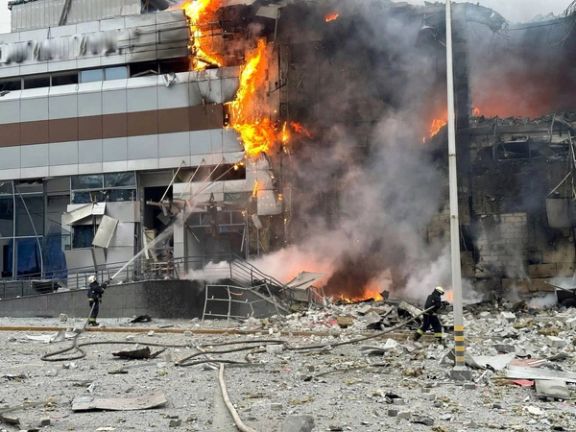
Russia launched 122 missiles and 36 drones against Ukrainian targets, killing at least 13 civilians in what was described as the biggest barrage of the 22-month war.
Ukraine’s military chief, Valerii Zaluzhnyi, said Friday that the Ukrainian air force intercepted 87 of the ballistic and cruise missiles and 27 of the Shahed-type drones overnight. The aerial attack that began Thursday and continued through the night, hitting six cities, including the capital, Kyiv, and other areas from east to west and north to south Ukraine.
Air Force commander Mykola Oleshchuk wrote on his official Telegram channel that it was “the most massive aerial attack” since Russia’s full-scale invasion in February 2022.
At least 88 people were injured and an unknown number were buried under rubble during the roughly 18-hour onslaught, Ukrainian officials said. Among the buildings reported to be damaged across Ukraine were a maternity hospital, apartment blocks and schools.

Ukrainian President Volodymyr Zelenskyy said on X, “Today, Russia used nearly every type of weapon in its arsenal.”
Air Force spokesperson Yurii Ihnat said on air that an attack of this scale "has not been seen for a long time." According to the Ukrainian air force, the previous biggest assault was in November 2022 when Russia launched 96 missiles against Ukraine.
Western officials and analysts have recently warned that Russia had limited its cruise missile strikes in recent months in an apparent effort to build up stockpiles for massive strikes during the winter.
Iran has supplied hundreds of the kamikaze Unmanned Aerial Vehicles (UAV) to Russia since mid-2022, which Moscow has used extensively to target civilian infrastructure and cities.
The drones are also used during massive missile attacks to overwhelm Ukrainian air defenses. The drones are relatively cheap, costing around $20,000 each and Ukraine sometimes has to fire much more expensive anti-air missiles to bring them down.
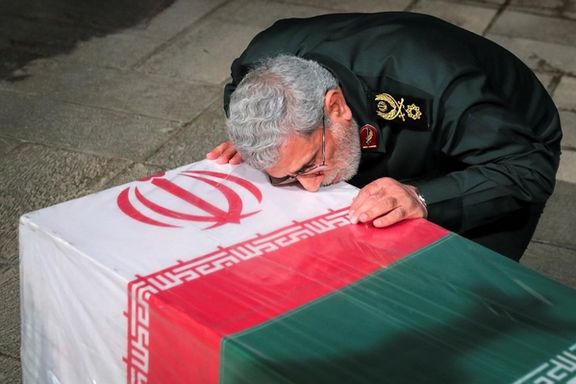
Saudi and Israeli media reported Friday that 11 senior officers of Iran’s Revolutionary Guards were killed in the Thursday Israeli air strike on Damascus airport.
According to Al Arabiya sources, the targeted IRGC members, responsible for overseeing Iran-backed forces in eastern Syria, were at the airport to welcome a senior delegation. IRGC spokesman Ramezan Sharif denied the report on Friday without providing any details.
One of the IRGC commanders in Syria, Major General Gholam-Ali Rashid Ali-Nour, was also injured in the airstrike, Saudi media channel Al-Hadath reported.
The attack near the airport came "one whole day after the airport resumed flights," said the British-based monitor the Syrian Observatory for Human Rights.
Israel rarely comments on strikes targeting Syria, but it keeps reiterating that it will not allow its nemesis Iran to entrench itself in the country. Israel has been regularly attacking targets in Syria since 2017 to weaken Iran's attempts to strengthen its military presence in the war-torn country and build up a threat on Israel's northern borders. In the past year, Syrian airports have become frequent targets, as Iran is reportedly shipping weapons for its proxy forces by planes.
Earlier this week, the IRGC confirmed that one of its top commanders in Syria, Brig. Gen. Razi Mousavi, was killed in an Israeli “missile attack.”
Iranian President Ebrahim Raisi and several other military commanders have issued messages, warning that Israel “will certainly pay for this crime.”